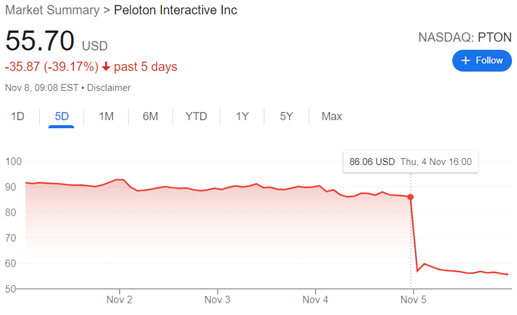Peloton’s uphill battle with the world’s return to order
In this article, William ANTHONY (ESSEC Business School, Global Bachelor of Business Administration, Exchange Student from the University of Bath, 2021-2022) discusses the market reaction to Peloton’s quarterly results.
Description of the firm
Peloton is an American company which produces exercise equipment and media streaming. Its best-seller ‘Gen 3 Peloton bike’ is available in the US, UK, Germany, Australia, and parts of Canada. With significant increases in sales during the COVID pandemic, Peloton became a public company via IPO on September 26th, 2019. At the time of writing, the company is currently valued at $16.85Bn (Market Capitalization as of 07/11/2021).

Description of the event
Peloton reported weakening sales on the 4th of November 2021 and a larger loss than expected for its first fiscal quarter. As consumers begin to return to gyms, a step closer to a pre-pandemic environment, John Foley, Peloton CEO, admits to ongoing “supply chain constraints” and “demand uncertainty amidst re-opening economies”. The fall in demand growth for Peloton’s exercise equipment has subsequently lowered the demand for its subscription-based products which has also contributed to lower profit margins.
My explanation of the market reaction to the event
The weaker than expected sales growth report led to a decrease in Peloton’s share price by nearly 40% from $86 to $60 as illustrated in Figure 1 below. In their fiscal first quarter, Peloton’s loss per share was expected at $1.07 but was instead $1.25; revenue was expected at $810.7 million but was instead $805.2 million. Despite a surge of 148% in sales and marketing expenses to $284.3 million, which represents around 35% of Peloton’s revenue, the firm was still unable to show strong growth figures coming out of the Covid-19 pandemic. This is extremely worrying and underlines Peloton’s “challenged visibility” (John Foley, 2021).
CNBC’s Jim Cramer advised his audience to sell Peloton on the next bounce after what he called a “disastrous” quarterly result. When looking at gyms like Planet Fitness Inc which have increased by nearly 20% in the last 5 days in share price, I believe there is reason for worry for Peloton shareholders. The lack of direction from Peloton management regarding a post-pandemic market and ongoing supply chain challenges leaves Peloton with a ‘sell’ market consensus and for me justifies its cliff-diving share price.

Justification of my choice of the event and the firm
I chose this event because it is very recent, it is also a great example of how news regarding stagnant growth can negatively affect a company’s share price. In this example, one of the top fitness companies in the world that gained massive momentum over the global COVID pandemic, saw all its shareholders lose up to 40% of their investment in one single after-hours trading session. Here we have witnessed how ruthless the market can be in just a couple of hours.
My thoughts on the market efficiency
Eugene Fama distinguishes three levels of informational market efficiency:
- Weak efficiency: all information contained in past stock market data (prices and transaction volumes) is already reflected in today’s price.
- Semi-strong efficiency: in addition to the information contained in historical stock market data, all public information (company accounts, analyst reports, etc.) is already reflected in today’s price.
- Strong efficiency: all information, public as well as private, is already reflected in today’s price.
I believe in Peloton’s case that the market has shown itself to have semi-strong efficiency. Within hours of private information being made public, the company share price reflected an adjusted rate relating to the newly released quarterly report information. As a result of the market incorporating the news into the price with such rapidity, the market was hard to ‘beat’ due to shareholders willingness to sell their shares.
Useful resources
Academic references
Fama E. (1970) « Efficient Capital Markets: A Review of Theory and Empirical Work » Journal of Finance, 25, pp. 383-417.
Fama E. (1991) « Efficient Capital Markets: II » Journal of Finance, 46, pp. 1575-617.
Business
Related posts on the SimTrade blog
▶ Wan J. What I learned from my time on the stock market
▶ Paulen J. The IRR function in Excel
About the author
The article was written in November 2021 by William ANTHONY (ESSEC Business School, Global Bachelor of Business Administration, Exchange Student from the University of Bath, 2021-2022).

